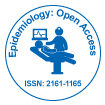A Brief Note on Nutritional Epidemiological Studies and its Science
Received Date: Dec 01, 2022 / Published Date: Dec 30, 2022
Abstract
Nutritional epidemiology is a relatively new field of medical research that studies the relationship between nutrition and health. It is a young discipline in epidemiology that is continuing to grow in relevance to current health concerns. Diet and physical activity are difficult to measure accurately, which may partially explain why nutrition has received less attention in epidemiology than other risk factors for disease. Nutritional epidemiology uses knowledge from nutritional science to aid in the understanding of human nutrition and the explanation of basic underlying mechanisms. Nutrition The development of dietary recommendations, including those tailored specifically for the prevention of certain diseases, conditions, and cancers, is influenced by these studies' findings, which have an impact on public health. Western researchers say that nutritional epidemiology should be a core part of training for all health and social service professionals because of its growing importance and past successes in improving public health. However, they also say that nutritional epidemiological studies don't always come up with reliable results because they rely on the role that diet plays in health and disease, which is known as an exposure that is prone to a lot of measurement error.
Citation: Stedingk K (2022) A Brief Note on Nutritional epidemiological studies and its Science. Epidemiol Sci, 12: 476. Doi: 10.4172/2161-1165.1000476
Copyright: © 2022 Stedingk K. This is an open-access article distributed under the terms of the Creative Commons Attribution License, which permits unrestricted use, distribution, and reproduction in any medium, provided the original author and source are credited.
Share This Article
Recommended Journals
Open Access Journals
Article Tools
Article Usage
- Total views: 1875
- [From(publication date): 0-2022 - Mar 31, 2025]
- Breakdown by view type
- HTML page views: 1539
- PDF downloads: 336
